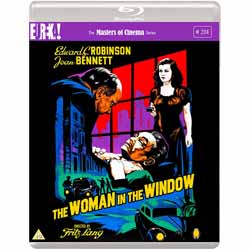|
Click here to return to the main site. Blu-ray Review
The thesis of Sam Harris’s contemporary blend of philosophy, religion analysis and neuro-science, The End of Freedom, is that freedom is a tired old shibboleth, a construct that does not exist. Not now or ever. Freedom of choice is a construct of givens, the luck of the draw, depending on upbringing, genetic legacy, current brain chemistry or just a lucky break at being at the right place at the right time or as the prolific Fritz Lang instructs us in The Woman in the Window, the wrong place at the right time. Destiny can take charge of any soul and chart a new course without freedom of consent. The key word for both Harris and Lang is impulse. We all have them. Some of us have balance of mind and luck of situation to enable choosing against destructive impulses. Most of the time. Harris is very freeing (pun intended) to describe his own impulses and it gives us solace to realize we’re not alone and at the same time we must absorb his point. Lang’s film begins with psychiatric professor Richard Wanley (Robinson) concluding a classroom lecture on, you guessed it, impulse in human consciousness. Wanley is a seamless gentleman, a kindly soul, an enlightened intellect. Bidding his adoring wife and children goodbye, he’s on his own for a few days. A tiny irony is his beatific little boy: an uncredited Robert Blake who will grow up to play the ultimate impulse killer, Perry Smith, in Richard Brook’s cinematic masterpiece of Truman Capote’s In Cold Blood (1967) wherein the question of impulse would be pondered right up to the hangman’s scaffold in Leavenworth prison. Blake’s most poignant line, ‘I’d like to apologize… but I don’t know who to.’ Woman in the Window is described as one of the first film noirs but as we read scholars of the subject, that is a post war label from the French critics. Noir is more than a tale from the shadowy urban settings we live in it is the shadow within our minds. It is the relentlessness of impulse, bad breaks, bad company and unfortunate cards from the croupier. Wanley becomes entranced with a woman’s portrait in an art house window, (Joan Bennett). His friends, including a district attorney (Massey) witness his mesmerized gaze and tease him playfully. Later, after drinks at their club, Robinson returns to woman in the window and suddenly in the reflection she is standing behind him, watching him watching her. If anything Bennett’s Alice is more beautiful in life than in portrait. Robinson is enchanted. Bennett is decent, witty and in no ways cheaply flirtatious. She views Robinson the same way and invites him to her apartment for drinks. Strictly above board. A crude, boorish bully enters the apartment, attacks Robinson to kill him and in self defence Robinson kills him. There it is. Alice is actually a kept woman, an upper bracket sex toy. The dead boor is a millionaire. Professor Wanley has a bulky body to haul away. Of course it is discovered by a snottily officious Eagle Scout and forensic evidence is chatted about at the gentlemen’s club by Massey. Complicating it all, is Alice’s weaselly acquaintance (Dan Duryea, one of the best weasels in the business, a casting reputation he owed in a big part to Lang and this movie). Withal, Professor Wanley keeps circling the drain of oblivion. Lang’s scene by scene architecture is elegant without the angular pretence of Hitchcock and therefore hasn’t the affectation and is more mature, more sublime and why Lang is always above Hitchcock on the cinematic staircase. Lang’s work, especially here, is not trick rider cinema but a sensuous exploration of the cave of dread that is in everybody’s head. Establishing identification with Robinson’s character is so benign, so cunningly directed and acted, it’s hard to accept that this is the same actor, only months removed, who would unwittingly dog a homicidal Fred MacMurray and confess his love to him in the last spoken lines of Billy Wilder’s Double Indemnity (1944). Robinson’s range is Shakespearean. Lang’s aesthetic monocle is ever scrupulous to Heideggerian sorge (high worry or concern). This Eureka 1080p remaster lifts the best image possible from the original studio nitrate negative. Crystal clear. They are to be thanked. Extras include film noir scholars with multiple perspectives. All valuable. Though I recommend the viewer dive into Lang’s dark pool without any swimming lessons first time around. Be your own film philosopher. Learning to swim in Lang will drown-proof you from movie tsunami dreck. You’ll profit more from the scholars after that. And I think Lang would want that for you too. Imagining this Master of Cinema classic in first run theatres back in 1944 is a time machine experience. All the players are gone. But the exquisite screenplay by Nunnally Johnson (Grapes of Wrath, 1940; Roxie Hart, 1942) and cinematography by Milton Krasner, keep it as alive and vital as when it was first experienced. But you’re here now and art lives in the knowing, doesn’t it? A cautionary tale of impulse and destiny, versus the illusion of freedom has no expiration date. (There but for the grace of Lang go I… or you…?) Woman in the Window is rewatchable (on a nice big clean screen, not a teensy weensy pocket piece, okay?) and each time something new is stimulated in the maze of mind. 10 John Huff Buy this item online
|
|---|

